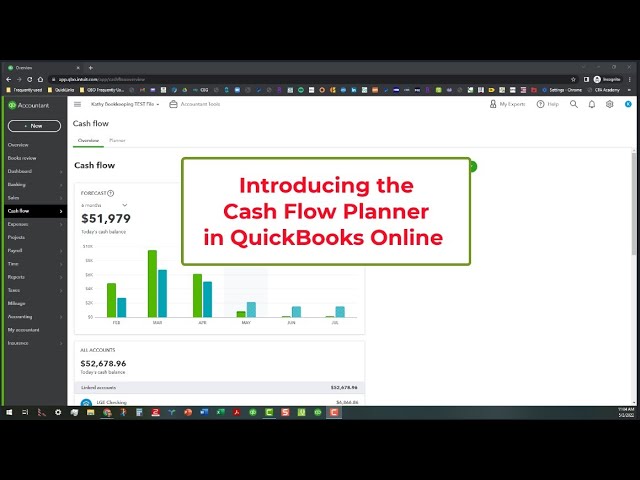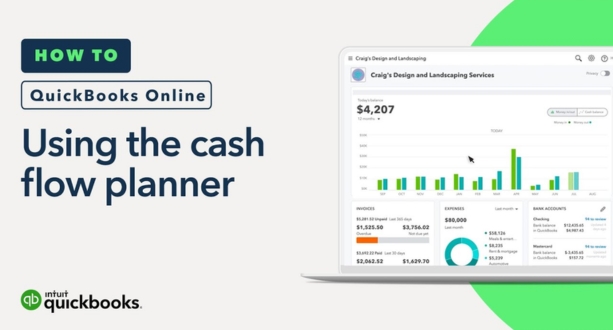Introduction
Cash Flow Management is a vital aspect of financial stewardship for businesses, encompassing the strategic control and optimization of the inflow and outflow of cash within an organization. In the dynamic landscape of commerce, understanding, and mastering Cash Flow Management is paramount for sustained growth, operational stability, and financial resilience. In this comprehensive guide, we delve into the intricacies of Cash Flow Management, emphasizing its definition, the critical importance it holds for businesses, and the instrumental role that QuickBooks plays in facilitating this process.
Definition of Cash Flow Management

At its core, Cash Flow Management refers to the efficient monitoring, analysis, and control of the cash that moves in and out of a business. It involves a strategic approach to ensure that a company has enough liquidity to meet its short-term obligations while also optimizing the allocation of excess funds for future growth or investment. Cash Flow Management is not merely a financial exercise but a strategic imperative that requires foresight, planning, and adaptability to navigate the complexities of the business environment.
Importance of Effective Cash Flow Management
The significance of effective Cash Flow Management cannot be overstated. It serves as the lifeblood of any business, influencing every facet of its operations. One of the primary benefits is the ability to meet financial obligations promptly, including payments to suppliers, employee salaries, and other day-to-day expenses. A well-managed cash flow ensures that a business can seize opportunities, weather economic downturns, and invest in innovation.
Moreover, efficient Cash Flow Management contributes to financial stability, providing a buffer against unforeseen circumstances. Businesses with a solid grasp of their cash flow are better equipped to navigate challenges such as economic recessions, supply chain disruptions, or unexpected expenses. This resilience is a key factor in long-term sustainability.
Additionally, effective Cash Flow Management fosters better decision-making. It provides insights into the financial health of the business, enabling informed choices regarding investments, expansion, or cost-cutting measures. With a clear understanding of cash flow patterns, businesses can optimize their financial strategies to maximize profitability and growth.
A Brief Overview of QuickBooks’ Role in Cash Flow Management
QuickBooks, a leading accounting software solution, plays a pivotal role in simplifying and enhancing Cash Flow Management for businesses of all sizes. With its user-friendly interface and robust features, QuickBooks empowers users to gain real-time visibility into their financial landscape. Here are some key aspects of QuickBooks‘ role in Cash Flow Management:
Streamlining Financial Processes

QuickBooks offers a centralized platform for managing various financial processes, from invoicing and payments to expense tracking and financial reporting. By automating repetitive tasks, QuickBooks helps businesses save time and reduce the risk of errors, ensuring accuracy in financial transactions.
Real-time Monitoring and Reporting
One of QuickBooks’ strengths is its ability to provide real-time insights into cash flow. Users can generate customized reports that offer a clear overview of income, expenses, and cash position. This real-time visibility enables businesses to make informed decisions promptly.
Cash Flow Forecasting

QuickBooks facilitates cash flow forecasting by allowing users to create projections based on historical data and anticipated future transactions. This proactive approach enables businesses to identify potential cash flow gaps and take preventive measures.
Integration with Banking and Financial Institutions
QuickBooks seamlessly integrates with bank accounts and financial institutions, automating the reconciliation process. This integration ensures that businesses have an accurate and up-to-date understanding of their cash position, eliminating the need for manual data entry.
In conclusion, QuickBooks serves as a valuable ally in the realm of Cash Flow Management, providing businesses with the tools and insights needed to optimize their financial health. As we journey through this guide, we will explore in greater detail the specific features and functionalities of QuickBooks that contribute to efficient Cash Flow Management.
Understanding Cash Flow
What is Cash Flow?
Cash Flow is the lifeblood of any business, representing the movement of money in and out of the company during a specific period. It provides a comprehensive view of the financial health by tracking the cash inflow and outflow. Let’s delve into the components that constitute this fundamental concept.
Definition and Components
- Cash Inflow:
Cash inflow encompasses all sources of money entering the business. This includes revenue from sales, investments, loans, and any other form of income. In the context of operations, it’s the cash generated from the primary activities of the business, such as selling goods or services.
- Cash Outflow:
On the flip side, cash outflow encompasses all expenditures and payments made by the business. This includes operating expenses, salaries, loan repayments, and any other form of financial outlay. Effective management of cash outflow ensures that a business can meet its obligations without compromising its financial stability.
Understanding the dynamics between cash inflow and outflow is crucial for maintaining liquidity and sustaining operations. It provides insights into the timing of income and expenses, allowing businesses to anticipate and prepare for financial fluctuations.
Importance of Positive Cash Flow

Maintaining a positive cash flow is not merely a financial goal; it is a strategic imperative with far-reaching implications for a business’s overall health and longevity.
Impact on Business Operations
- Meeting Short-Term Obligations:
Positive cash flow ensures that a business can meet its short-term financial obligations. Whether it’s paying suppliers, covering utility bills, or settling immediate expenses, having cash readily available is essential for the smooth functioning of day-to-day operations.
- Flexibility in Decision-Making:
A positive cash flow provides businesses with the flexibility to make strategic decisions. Whether seizing opportunities for expansion, investing in technology, or navigating unexpected challenges, having a financial cushion enables businesses to act decisively.
- Reducing Dependency on Debt:
Businesses with positive cash flow are less reliant on external financing. This reduces the need for borrowing and the associated interest costs. The ability to fund operations from internal sources enhances financial independence and stability.
Sustainable Growth
- Investment in Innovation:
Positive cash flow creates the financial capacity for businesses to invest in innovation. This could involve research and development, the adoption of new technologies, or the exploration of new markets. Innovation is often a catalyst for long-term growth and competitiveness.
- Expansion Opportunities:
Sustainable growth requires capital, and positive cash flow positions businesses to explore expansion opportunities. Whether opening new locations, entering new markets, or diversifying product offerings, a healthy cash flow is a key enabler of strategic expansion.
- Resilience During Economic Downturns:
In times of economic uncertainty or downturns, businesses with positive cash flow are better positioned to weather the storm. The ability to navigate challenging periods without compromising operations or resorting to drastic cost-cutting measures is a hallmark of financial resilience.
In essence, positive cash flow is not just a financial metric; it is a reflection of a business’s operational efficiency and strategic acumen. It forms the foundation for sustainable growth, allowing businesses to navigate the complexities of the business landscape with confidence and adaptability.
QuickBooks Overview
Introduction to QuickBooks
QuickBooks stands as a cornerstone in the realm of financial management for businesses of all sizes. It is a robust accounting software solution designed to simplify and streamline various financial processes. Let’s delve into the key features and capabilities that make QuickBooks an indispensable tool for businesses.
Features and Capabilities
- User-Friendly Interface:
QuickBooks is renowned for its user-friendly interface, making it accessible to users with varying levels of financial expertise. The intuitive design ensures that businesses can easily navigate through different features and functionalities without the need for extensive training.
- Invoicing and Payment Processing:
One of QuickBooks’ standout features is its invoicing capabilities. Businesses can create professional-looking invoices, customize them to reflect their brand, and send them directly to clients. The integration of payment processing options allows for seamless transactions, reducing the time between invoicing and receiving payments.
- Expense Tracking:
QuickBooks simplifies expense tracking by allowing businesses to categorize and monitor their expenditures efficiently. This feature is instrumental in gaining a comprehensive understanding of where the money is going, facilitating better budgeting and cost management.
- Bank Reconciliation:
The software automates the bank reconciliation process, minimizing errors and ensuring accuracy in financial records. QuickBooks seamlessly integrates with bank accounts, credit cards, and other financial institutions, providing real-time updates and reducing the need for manual data entry.
- Financial Reporting:
QuickBooks offers a robust suite of financial reporting tools. Users can generate a variety of reports, including profit and loss statements, balance sheets, and cash flow statements. These reports provide valuable insights into the financial health of the business, aiding in informed decision-making.
QuickBooks in Cash Flow Management
Streamlining Financial Processes
- Automated Data Entry:
QuickBooks significantly reduces the manual effort involved in data entry. By automating the recording of financial transactions, it minimizes the risk of errors and ensures that businesses have accurate and up-to-date financial records. This automation is particularly valuable in the context of cash flow management, where precision is paramount.
- Real-Time Cash Flow Visibility:
One of QuickBooks’ strengths lies in its ability to provide real-time visibility into cash flow. Users can access dashboards and reports that offer a clear overview of income, expenses, and overall cash position. This instant access to financial information empowers businesses to make timely decisions and proactively manage their cash flow.
- Invoice Tracking and Reminders:
QuickBooks facilitates efficient invoice tracking, allowing businesses to monitor the status of invoices and receive timely reminders for overdue payments. This proactive approach to accounts receivable is instrumental in maintaining a healthy cash flow by reducing the instances of late or missed payments.
- Expense Management and Budgeting:
The software’s robust expense tracking capabilities contribute to effective cash flow management. Businesses can set budgets, monitor actual expenses against projections, and identify areas for cost optimization. This proactive budgeting approach aids in preventing overspending and aligning financial activities with business goals.
In conclusion, QuickBooks serves as a comprehensive solution for businesses seeking to optimize their cash flow management. From automating financial processes to providing real-time insights, QuickBooks empowers businesses to navigate the complexities of financial management with efficiency and precision.
Tips for Efficient Cash Flow Management with QuickBooks
Efficient Cash Flow Management is not just about recording financial transactions; it’s about leveraging tools and strategies to optimize the movement of funds within a business. QuickBooks, with its robust features, plays a pivotal role in achieving this goal. In this section, we will explore practical tips for maximizing Cash Flow Management using QuickBooks.
Setting Up QuickBooks for Cash Flow Tracking
Creating and Customizing Accounts
One of the foundational steps in efficient Cash Flow Management with QuickBooks is setting up and customizing accounts to accurately reflect the financial structure of your business.
- Chart of Accounts:
Begin by creating a comprehensive Chart of Accounts. QuickBooks provides a default chart, but tailoring it to your specific business needs is crucial. Include categories such as income, expenses, assets, liabilities, and equity. This customization ensures that your financial data is organized in a way that aligns with your business operations.
- Sub Accounts and Classes:
Utilize sub accounts and classes to further categorize transactions. This level of granularity enhances the specificity of your financial reporting. For instance, under expenses, you can create sub accounts for various cost centers, providing a detailed breakdown of where the money is spent.
Linking Bank and Credit Card Accounts
- Bank Feeds:
Linking your bank and credit card accounts to QuickBooks through bank feeds is a time-saving feature. It automates the process of importing transactions, minimizing manual data entry. Regularly reconciling these accounts ensures that your QuickBooks records align with your actual financial transactions.
- Reconciliation and Accuracy:
Regular reconciliation is vital for accuracy. QuickBooks simplifies this process by providing a reconciliation feature that allows you to match transactions in your accounts with those in your bank statements. This step is crucial for identifying discrepancies and maintaining the integrity of your financial data.
Invoicing and Receivables
Generating Professional Invoices
- Customization:
QuickBooks enables you to create professional and customized invoices. Tailor them to reflect your brand identity, and include all necessary details such as itemized charges, payment terms, and due dates. A professional-looking invoice not only instills confidence in clients but also helps expedite payment.
- Automation:
Take advantage of automated invoicing features in QuickBooks. Schedule recurring invoices for clients with regular billing cycles. This automation not only saves time but also ensures consistency in your invoicing process.
Tracking Customer Payments
- Payment Reminders:
Use QuickBooks to set up payment reminders for overdue invoices. Automated reminders help prompt clients to make payments on time, reducing the likelihood of delayed or missed payments.
- Payment Integration:
Consider integrating payment options directly into your invoices through QuickBooks Payments or other payment gateways. This streamlines the payment process for clients and accelerates the collection of receivables.
Payables and Expense Management
Managing Supplier Payments
- Bill Pay Feature:
Leverage QuickBooks’ Bill Pay feature to manage and schedule payments to suppliers. This centralized approach simplifies the accounts payable process and helps in avoiding late payment penalties.
- Cash Flow Projections:
Monitor your payables to anticipate cash flow fluctuations. QuickBooks allows you to project future cash flows based on scheduled payments. This foresight is invaluable for making informed financial decisions.
Expense Tracking
- Categorization and Tags:
Regularly categorize and tag expenses to provide a detailed breakdown of where your money is going. QuickBooks allows for the easy classification of expenses, enabling you to analyze spending patterns and identify areas for potential cost savings.
- Receipt Capture:
Use QuickBooks’ receipt capture feature to digitally store receipts. This eliminates the need for physical paperwork and ensures that all expenses are accurately recorded. The integration of receipt details with transaction data enhances the transparency of your financial records.
Forecasting and Budgeting
Utilizing QuickBooks for Financial Projections
- Historical Data Analysis:
Leverage QuickBooks’ reporting tools to analyze historical financial data. By understanding past trends, you can make more accurate projections for the future. QuickBooks provides customizable reports that allow you to analyze cash flow, income, and expenses over different periods.
- Budget Creation:
Utilize QuickBooks to create detailed budgets. Inputting revenue and expense projections into the system helps in setting financial goals and benchmarks. Regularly compare actual performance against budgeted figures to identify variances and make adjustments as needed.
Budget Monitoring
- Variance Analysis:
Regularly monitor variances between budgeted and actual figures. QuickBooks’ reporting features make it easy to compare budgeted amounts with real-time data. This analysis provides valuable insights into financial performance and helps in making informed adjustments to stay on track.
- Rolling Forecasts:
Implement rolling forecasts in QuickBooks to extend your financial planning beyond fixed budget periods. This dynamic approach allows you to continuously update projections based on the latest information, adapting to changes in the business environment.
In conclusion, optimizing Cash Flow Management with QuickBooks involves more than just data entry; it requires strategic utilization of its features. By setting up accounts meticulously, leveraging automation in invoicing and payments, tracking expenses effectively, and utilizing forecasting and budgeting tools, businesses can harness the full potential of QuickBooks for efficient Cash Flow Management.
Common Challenges and Solutions
Efficient Cash Flow Management is not without its challenges, but with the right strategies and tools, businesses can navigate these obstacles successfully. In this section, we’ll explore common challenges faced by businesses and how QuickBooks features can serve as effective solutions.
Identifying Cash Flow Challenges
Late Payments
- Delayed Invoicing:
Late payments often stem from delayed invoicing. If your business doesn’t send out invoices promptly, clients may not prioritize timely payments. QuickBooks addresses this challenge by streamlining the invoicing process. With customizable invoice templates and automated scheduling, businesses can ensure that clients receive invoices promptly, reducing the likelihood of delayed payments.
- Payment Terms Clarity:
Unclear or inconsistent payment terms can contribute to late payments. QuickBooks allows businesses to clearly define payment terms on invoices. Additionally, businesses can use the software to set up automated reminders for clients as payment due dates approach, fostering a more transparent and organized payment process.
Seasonal Fluctuations
- Inconsistent Revenue Streams:
Seasonal fluctuations can result in inconsistent revenue streams, making it challenging to maintain stable cash flow. QuickBooks offers tools for businesses to analyze historical financial data, helping them identify seasonal patterns. By understanding peak and off-peak periods, businesses can develop strategies to manage cash flow effectively during both high and low seasons.
- Forecasting Tools:
QuickBooks’ forecasting tools enable businesses to project cash flow based on historical data. This allows for better anticipation of seasonal challenges and helps in creating contingency plans. By using the forecasting features, businesses can proactively address potential cash flow gaps during slower seasons.
QuickBooks Features for Overcoming Challenges
Alerts and Notifications
- Overdue Invoice Alerts:
QuickBooks provides alerts and notifications for overdue invoices. Businesses can set up automated reminders to notify clients when payments are past due. This feature serves as a proactive measure to prompt clients to settle outstanding invoices promptly.
- Budget Variance Alerts:
Utilizing budgeting features in QuickBooks allows businesses to set financial goals. The software can generate alerts when actual performance deviates from the budget. This early warning system enables businesses to identify and address financial challenges promptly.
Cash Flow Reporting
- Real-time Cash Flow Statements:
QuickBooks offers real-time cash flow statements that provide a comprehensive view of a business’s financial health. By regularly reviewing these statements, businesses can quickly identify potential challenges and take immediate action.
- Cash Flow Projections:
The software’s cash flow projection tools enable businesses to forecast future cash flows based on historical data and anticipated transactions. This forward-looking approach helps in preparing for potential challenges and making informed financial decisions.
In conclusion, QuickBooks serves as a valuable ally in overcoming common cash flow challenges. By addressing issues such as late payments through streamlined invoicing and payment terms clarity, and managing seasonal fluctuations through forecasting tools, businesses can enhance their Cash Flow Management strategies.
By leveraging QuickBooks’ features for alerts and notifications, businesses can proactively address overdue invoices and budget variances. The availability of real-time cash flow statements and projection tools further empowers businesses to navigate challenges with confidence and precision.
Case Studies
Real-life Examples of Successful Cash Flow Management with QuickBooks
-
Case Study 1: Streamlining Invoicing Processes
Business Profile:
A small consulting firm faced challenges with delayed payments due to manual invoicing processes.
Solution with QuickBooks:
By implementing QuickBooks’ invoicing features, the firm automated their invoicing system. Customizable templates, automated scheduling, and real-time tracking reduced the time between service delivery and invoicing. Resultantly, the firm experienced a significant reduction in overdue payments, improving overall cash flow.
-
Case Study 2: Managing Seasonal Fluctuations
Business Profile:
A retail business with seasonal peaks and troughs struggled with maintaining cash flow during slow periods.
Solution with QuickBooks:
Utilizing QuickBooks’ forecasting tools, the business analyzed historical sales data to identify seasonal patterns. With this insight, they created flexible budgets and cash flow projections. During off-peak seasons, the business adjusted inventory levels and implemented targeted marketing campaigns to maintain consistent cash flow throughout the year.
-
Case Study 3: Overcoming Late Payments
Business Profile:
A graphic design agency faced challenges with clients consistently making late payments.
Solution with QuickBooks:
QuickBooks’ alerts and reminders were leveraged to notify clients of upcoming payment deadlines. Additionally, the agency implemented clear payment terms on invoices generated through QuickBooks. The combination of timely reminders and transparent communication resulted in a significant reduction in late payments, improving the agency’s cash flow reliability.
These real-life case studies illustrate how businesses, by strategically utilizing QuickBooks’ features, have successfully overcome common cash flow challenges. Whether streamlining invoicing, managing seasonal fluctuations, or addressing late payments, QuickBooks proves to be a versatile tool in promoting effective Cash Flow Management.
Conclusion
Effective Cash Flow Management is the linchpin of financial success for any business, and QuickBooks emerges as a powerful ally in this pursuit. As we conclude this comprehensive guide, it’s evident that businesses leveraging QuickBooks can navigate the complexities of cash flow with precision and confidence.
By employing the robust features of QuickBooks, businesses can streamline financial processes, automate invoicing, and gain real-time insights into their cash position. The ability to set up and customize accounts, link bank and credit card accounts, and utilize forecasting tools contributes to a holistic approach to Cash Flow Management.
The challenges of late payments and seasonal fluctuations, common stumbling blocks for many businesses, find practical solutions through QuickBooks. The software’s features, such as alerts and notifications, cash flow reporting, and budgeting tools, equip businesses to proactively address issues and maintain financial stability.
The real-life case studies presented showcase tangible success stories where businesses have harnessed QuickBooks to overcome challenges and optimize their cash flow. Whether it’s a small consulting firm streamlining invoicing processes or a retail business managing seasonal variations, QuickBooks proves its adaptability and effectiveness.
In conclusion, integrating QuickBooks into your Cash Flow Management strategy is not just a choice; it’s a strategic decision for financial resilience and sustainable growth. The journey to efficient Cash Flow Management is an ongoing process, and with QuickBooks as your trusted companion, you’re well-equipped to navigate the ever-changing financial landscape.
As you embark on implementing these strategies and insights, may your business thrive and prosper through the lens of optimized Cash Flow Management with QuickBooks.








